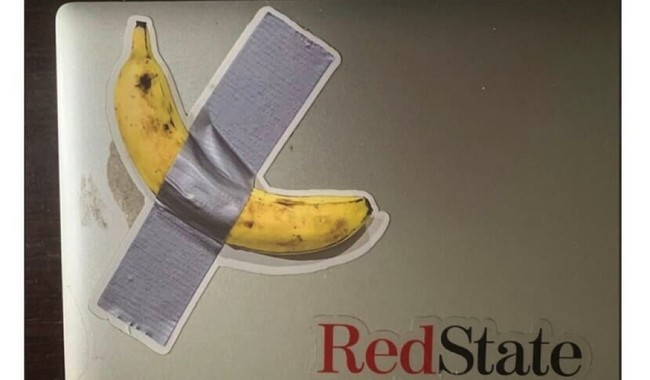There were some melodramatics at a museum in the Netherlands this week. Panic erupted at the LAM Museum in Lusse, Holland, when one of their artworks turned up missing. After an anxiety-filled search, they came to discover the work in a garbage bin and gratefully found that it had not been damaged and was able to be displayed once again. How this transpired explains much that is wrong with the art world.
Art, like food and comedy, and so many other aspects of our culture, is subjective. One man’s masterpiece is another man’s eyesore. A prime example of this lies in the story of a picture of a man discovered in a basement that was found to be a Picasso, valued at over $6 million. It was interred deep in their home because his father, a junk dealer, acquired the piece in his vocation, but his wife declared it to be ugly, so it was stashed away with the sewing mannequins and unused ski equipment.
Now, while I recognize that a work can influence individuals differently at the same time, I have no qualms in calling out the efforts (or lack thereof) seen in many modern artworks. Over the years, we have seen instances where quotidian displays by untalented hacks were touted and sold for a free agent’s salary: One word repeatedly stenciled in black, a urinal bolted to a wall, or a canvas filled with a solitary color have been deemed masterworks. There seems to be in play a scale where an artist’s lack of talent is counterbalanced by their sheer audaciousness.
A prime example of this arrived a few years ago, courtesy of my daughter. She did not create this, but was on the frontline of an international story. She was attending Art Basel in Miami, an annual gathering of artists of multiple disciplines. She sent me a text from the event one day to show me one of the installations: A banana was duct taped to a wall. This became one of our touchstone jokes and has been a regular feature on my podcast, The Cocktail Lounge.

It also became an international sensation in a matter of days. (We are not taking credit.) Entitled “Comedian,” Italian artist Maurizio Cattelan actually sold it for over $120,000. How, you are surely asking? What the museums purchased was the right to display his “art” with a printout of specific instructions on how it is to be displayed, detailing everything from the type of banana to be purchased, its level of ripeness, the length and cut of the duct tape, as well as the angle it is to be displayed and then affixed. (To give a sense of the artistic import, while still on display at the Art Basel event someone removed his banana and ate it on premises.)
This type of art is one which I classify with my own genre – Created Under a Deadline. You have no artistic skill, no work to present, and yet you have to supply a museum or an event with a piece by a specific date, so in a panic, you cobble together anything you can find and then simply insist it is art. Normally, it helps to concoct an obtuse explanation of the symbolism in a paragraph to display with your masterwork, one that manages to say nothing using multisyllabic terms that amount to exactly zero, doing so in a flourish that would impress Kamala Harris when asked a direct question.
Which brings us to the museum in the Netherlands. Now, arguably, this was not a toss-off effort, but some work was, in fact, involved, yet the effect was no different. In fact, if you strive to put time into your entry and it still gets regarded as nothing more than what needs to be tossed out in the recycle bin, then you may need to question your medium.
The work by artist Alexandre Lavet, entitled “All The Good Times We Spent Together,” comprises two empty beer cans, at least one dented, positioned together. And, of course, we get the elevated language explaining why what appears to be refuse is a deeply trenchant commentary, “Mixing minimalism, contextual and conceptual art legacies – they ultimately embody precious moments of connection.”
New mechanic throws away beer cans at museum that were actually an art piecehttps://t.co/7UP5PCXOoB pic.twitter.com/HfNnC2tzFl
— The Washington Times (@WashTimes) October 9, 2024
This display leads to questionable artistic merit from the start, but it would be understandable if you were to ask: How would a worker grab an artwork from a display and toss it in the trash? This is because it was not displayed in the traditional manner. According to the museum, the work was not shown in the exhibition space where one would normally find featured works. Instead it was placed in the elevator of the museum – on the floor.
The LAM museum is renowned for showcasing its international art collection not only on walls and exhibition plinths but also in unconventional locations. Alexandre Lavet’s beer cans were exhibited inside the museum’s glass lift shaft, as if left behind by construction workers.
A replacement elevator technician, understandably, regarded the art as leftovers from the evening’s revelry. After a frantic investigation, the cans – sorry, the artwork – were discovered in the trash and recovered. The cans, which are actually hand-painted to display a non-existent beer brand, were not damaged and were moved to a more prominent location at the front of the museum to cash in on the hype generated by this news.
Now, for full disclosure, I have not matriculated from university with a master's in art history, nor trained professionally as a curator. That said, maybe when displaying art in unconventional locations and concerning a medium that resembles discarded party sodas, you should have something in place to indicate the artistic nature of the display? Maybe rope it off, feature the title of the work, or how about putting up a placard with the obtuse language for patrons — and especially custodial staffers — to grasp the significance of your soiled elevator??? Something like:
Lavet intends to highlight the nefarious division of the unauthorized yet ever-present caste system, whereby the elitist conventions in art are lionized via conventional elevations of stature, while the enervated working class is relegated to no better a strata than a commuter conveyance. Their preferred potable represents the futility of their plight, the mass-produced beverage made in uniform fashion and each container indistinguishable from the next, casting the impoverished into a skein of anonymity, and - once the imbiber is rapaciously sated – ultimately becomes as disposable as the vessel tossed aside and defying further recollection.
Or, they are just two beer cans tossed onto the floor and declared to be art. If that’s the case, my laundry room where we toss the empties is basically the Louvre.














